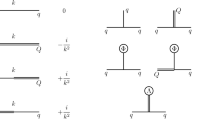Summary
In the Yang-Mills theory a formalism corresponding to the conventional Gupta-Bleuler formalism in quantum electrodynamics leads to difficulties with regard to the probability interpretation. It is shown that the tree diagrams of theS-matrix are gauge invariant and that nevertheless theS-matrix leads out of the physical subspace

with positive semi-definite metric. TheS-matrix projected onto the physical subspace hence is no longer unitary. In order to arrive at a unitary theory the original Gupta-Bleuler formalism has to be extended by introducing a complex scalar isovector field which obeys anticommutation rules. As a consequence, the usual connection between spin and statistics does not hold in the large state space. This does not pose any difficulty because an indefinite metric is used in the state space. The scalar fermions contribute in such a peculiar way as to cancel all bad effects of the Gupta-Bleuler ghosts in the original formulation, yielding, therefore, the correct Feynman diagrams with the usual analyticity properties. It is possible to give a consistent probability interpretation for the asymptotic particles within this formalism without any additional unitarization procedure. In comparison with quantum electrodynamics the ghost structure is much more complicated and the indefinite metric nontrivial. Nevertheless, our notation of good and bad ghosts with some modification remains the most suitable language also in this extended Gupta-Bleuler formalism.
Riassunto
Nella teoria di Yang-Mills un formalismo corrispondente al formalismo convenzionale di Gupta-Bleuler nell'elettrodinamica quantistica porta a difficoltà per quanto riguarda l'interpretazione della probabilità. Si mostra che i diagrammi ad albero della matriceS sono invarianti di gauge e che, ciò nonostante, la matriceS porta fuori dal sottospazio fisico

con metrica semidefinita positiva. La matriceS proiettata sul sottospazio fisico non è quindi più unitaria. Allo scopo di giungere ad una teoria unitaria il formalismo di Gupta-Bleuler originale deve esser esteso introducendo un campo isovettoriale scalare complesso che obbedisce alle regole di anticommutazione. Di conseguenza l'usuale connessione fra spin e statistica non vale più nell'ampio spazio degli stati. Questo non comporta alcuna difficoltà perché nello spazio degli stati si usa una metrica indefinita. I fermioni scalari contribuiscono in modo così peculiare da cancellare tutti i cattivi effetti dei fantasmi di Gupta-Bleuler nella formulazione originale e portano ai corretti diagrammi di Feynman con le usuali proprietà di analiticità. In questo formalismo, senza alcuna procedura di unitarizzazione aggiuntiva, è possibile dare una coerente interpretazione della probabilità per le particelle asintotiche. In confronto con l'elettrodinamica quantistica la struttura dei fantasmi è molto più complicata e la metrica indefinita non è banale. Ciò nonostante, la nostra notazione di fantasmi buoni e cattivi, rimane, con qualche modifica, il linguaggio più opportuno in questo formalismo di Gupta-Bleuler esteso.
Резюме
В теории Янга-Миллса формализм, соответствущий общепринятому формализму Гупта-Щлейлера в квантовой электродинамике, приводит к трудностям, связанным с вероятностной интерпретацией. Показывается, что древовидные диаграммыS-матрицы являются калибровочно инвариантными и чтоS-матрица, тем не менее, выходит за физическое подпространство

с положительной полуопределенной метрикой. Следовательно,S-матрица, спроектированная на физическое подпространство, больше не является унитарной. Для того чтобы получить унитарпую теорию, первичный формализм Гупта-Щлейлера должен быть расширен посредством введения комплексного скалярного изовекторного поля, которое подчиняется антикоммутационным правилам. В результате этого обычная связь между спином и статистикой не вышолняется в пространстве больших состояний. Это не приводит к каким-либо трудностям, свяэанным с использованием индефинитной метрики в пространстве состояний. Скалярные фермионы дают вклад таким специфическим образом, что уничтожают все вредные эффекты дупа-Ълейлера в первоначальном формализме, приводя тем самым к корректным фейнмановским диаграммам с обычнми аналитическими свойствами. Оказывается возможным дать согласованную вероятностную интерпретацию для асимптотических частиц в рамках этого формализма без какой-либо дополнительной процедуры унитаризации. По сравнению с квантовой электродинамикой структура духов является много более сложной и индефинитная метрика является нетривиальной. Тем не менее, наша форма записи хороших и плохих духов с некоторыми модификациями остается наиболее удобным языком также и в обобщенном формализме Гупта-Ъпейлера.
Similar content being viewed by others
References
W. Heisenberg:Nucl. Phys.,4, 532 (1957).
W. Heisenberg:Introduction to the Unified Field Theory of Elementary Particles (London, 1967).
H. P. Dürr andE. Seiler:Nuovo Cimento,66 A, 734 (1970).
A. M. Gleeson, R. J. Moore, H. Rechenberg andE. C. G. Sudarshan: Austin preprint (1971).
T. D. Lee andG. C. Wick:Nucl. Phys.,9 B, 209 (1969).
E. Rudolph:Quantization problems in field theories with nonabelian gauge group, Doctoral Thesis, University of Munich (1970).
H. P. Dürr andE. Rudolph:Nuovo Cimento,62 A, 411 (1969).
H. P. Dürr andE. Rudolph:Nuovo Cimento,65 A, 423 (1970).
E. Rudolph:Indefinite metric in quantum electrodynamics and the theory of gravitons, Diploma Thesis, University of Munich (1967).
S. N. Gupta:Proc. Phys. Soc., A65, 161, 608 (1952).
Detailed version of this paper, not released for publication.
R. P. Feynman:Acta Phys. Polon,24, 697 (1963).
B. S. De Witt:Phys. Rev.,162, 1195, 1239 (1967);171, 1834 (E) (1968).
S. Mandelstam:Phys. Rev.,175, 1580 (1968).
L. D. Fadeev andV. N. Popov:Phys. Lett.,25 B, 29 (1967).
C. N. Yang andR. L. Mills:Phys. Rev.,96, 191 (1954).
E. S. Fradkin andI. V. Tyutin:Phys. Rev. D,2, 2841 (1970).
A. Maheshwari:Phys. Rev. D,2, 1436 (1970).
R. N. Mohapatra: New York preprint (1971).
G't Hooft: Utrecht preprint (1971).
J. Reiff andM. Veltman:Nucl. Phys.,13 B, 545 (1969).
S. K. Wong:Phys. Rev. D,3, 945 (1971).
R. L. Arnowitt andS. I. Fickler:Phys. Rev.,127, 1821 (1962).
H. G. Loos:Phys. Rev.,188, 2342 (1969).
S. Mandelstam:Phys. Rev.,175, 1604 (1968).
T. N. B. Kibble:The Quantum Theory of Gravitation in Seminar on High-Energy Physics and Elementary Particles (Trieste, 1965).
D. Lurié:Particles and Fields (New York, 1968).
N. N. Bogoliubov andD. V. Shirkov:Introduction to the Theory of Quantized Fields (New York, 1969).
Author information
Authors and Affiliations
Additional information
Traduzione a cura della Redazione.
Перевебено редакцией.
Rights and permissions
About this article
Cite this article
Rudolph, E., Dürr, H.P. Gupta-Bleuler formalism with scalar fermions in massless Yang-Mills theory. Nuov Cim A 10, 597–612 (1972). https://doi.org/10.1007/BF02899762
Received:
Published:
Issue Date:
DOI: https://doi.org/10.1007/BF02899762



